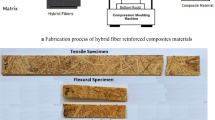Abstract
This study was conducted to investigate the elastic properties of High-Density Polyethylene (HDPE) reinforced with Single-Walled Carbon Nanotubes (SWCNTs) at various weight fractions. The HDPE/SWCNTs nanocomposites were produced using compression moulding. Six SWCNTs weight fractions and two compression loads were considered. The experimental approach was used for the investigation where the tensile tests were conducted. Twelve experiments were designed according to the Taguchi approach. The effect of the SWCNTs weight fraction and the compression load on the elastic properties of HDPE/SWCNTs nanocomposites were investigated. The results showed that the SWCNTs weight fraction has a much higher effect on the elastic modulus of nanocomposites compared to the effect of compression load. By adding 1.5 wt% of SWCNTs nanoparticles into HDPE matrix, the elastic modulus of HDPE/SWCNTs nanocomposites samples improved by 36% for those processed at the compression load of 2000 N and 29% for those processed at 3000 N. Furthermore, the stress–strain curves obtained during tensile test displayed the characteristics of the brittle materials which indicated that the nanocomposites produced were hard.







Similar content being viewed by others
References
ASTM Subcommittee D20.10 on Mechanical Properties (1995) Standard test method for tensile properties of thin plastic sheeting. American society for testing and materials
Arora G, Pathak H (2019) Numerical study on the thermal behavior of polymer nano-composites. J PhysConfSer IOP Publ 1240(1):012050
Azeredo HD (2009) Nanocomposites for food packaging applications. Food Res Int 42(9):1240–1253
British S, B. ISO (1992) Plastics—determination of tensile properties. Part 1 1992:527–521
Fahrenholz H (2018) The 2012 version of ISO 527 plastics: determination of tensile properties, Zwick/Roell
Ferreira F, Menezes B, Franceschi W, Ferreira E, Lozano K, Cividanes L, Coutinho A, Thim G (2017) Influence of carbon nanotube concentration and sonication temperature on mechanical properties of HDPE/CNT nanocomposites. Fullerenes Nanotubes Carbon Nanostruct 25(9):531–539
Najipour A, Fattahi A (2017) Experimental study on mechanical properties of PE/CNT composites. J TheorApplMech 55(2):719–726
Roozpeikar S, Fattahi A (2019) Evaluation of elastic modulus in PE/CNT composites subjected to axial loads. SN ApplSci 1(1):17
Tebeta R (2019) Investigation of mechanical properties of polyethylene-based Nano-composites. Master thesis, University of Johannesburg, South Africa
Tebeta R, Fattahi A, Ahmed N (2019) Prediction of the elastic behaviour of HDPE/SWCNTs nanocomposites with FEM approach. J PhysConfSer IOP Publ 1378(3):032073
Tebeta R, Fattahi A, Ahmed N (2020) Experimental and numerical study on HDPE/SWCNT nanocomposite elastic properties considering the processing techniques effect. MicrosystTechnol 2020:1–19
Thakur S, Sharma A, Batra N (2012) Tribological characterization of CNT/HDPE polymer nano-composites. Int J TheorAppl Res MechEng 1(1):32–36
Zou H, Wu S, Shen J (2008) Polymer/silica nanocomposites: preparation, characterization, properties, and applications. Chem Rev 10(9):3893–3957
Acknowledgements
The authors wish to acknowledge: The Department of Mechanical Engineering Science, Faculty of Engineering and the Built Environment, University of Johannesburg, South Africa. The National Research Foundation (NRF) of South Africa. And the URC of the University of Johannesburg.
Author information
Authors and Affiliations
Corresponding author
Additional information
Publisher's Note
Springer Nature remains neutral with regard to jurisdictional claims in published maps and institutional affiliations.
Appendix
Appendix
From Table 5, the average tensile test elastic modulus of the HDPE/SWCNTs nanoparticle processed at the compression load of 2000 N at o wt% and 1.5 wt% are 491.298 MPa and 666.669 MPa respectively, then the elastic modulus increase is:
From Table 5, the average tensile test elastic modulus of the HDPE/SWCNTs nanoparticle processed at the compression load of 3000 N at o wt% and 1.5 wt% are 577.439 MPa and 747.109 MPa respectively, then the elastic modulus increase is:
From Table 6, the average amount of the elastic modulus at the weight fractions of 0 wt% and 1.5 wt% SWCNTs are 534.369 MPa and 706.889 MPa respectively, then the elastic modulus increase is:
Rights and permissions
About this article
Cite this article
Tebeta, R.T., Ahmed, N.A. & Fattahi, A.M. Experimental study on the effect of compression load on the elastic properties of HDPE/SWCNTs nanocomposites. Microsyst Technol 27, 3513–3522 (2021). https://doi.org/10.1007/s00542-020-05098-9
Received:
Accepted:
Published:
Issue Date:
DOI: https://doi.org/10.1007/s00542-020-05098-9




